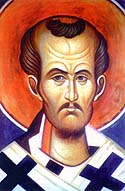|
|||
|---|---|---|---|
| This weekly bulletin insert complements the curriculum published by the Department of Christian Education of the Orthodox Church in America. This and many other Christian Education resources are available at http://dce.oca.org. | |||
|
The Church celebrates two saints who lived and worked in the city of Constantinople. The first is John Chrysostom, and the second is the Emperor Justinian. Saint John Chrysostom did so many important things that he is one of the best-known people who ever lived in the great city. One action that stands out is his speaking against moral laxness. He insisted that priests and bishops, especially, hold themselves to a high standard of moral behavior, and urged them to serve as examples both to believers and to those outside the Church. We might assume that his stance would be welcomed and supported by all the clergy. But there were those among them who had become accustomed to a life that didn't demand much of them in terms of moral living or hard work, and they deeply resented Chrysostom. He endured real hatred from those who had no desire to live up to the standards he set, and they watched with jealousy as he became a famous preacher and, more importantly, a spiritual shepherd loved and trusted by the people. He suffered from their envy and it finally led to his exile and death. But he never abandoned his struggle to live as a true follower of Christ. Justinian was born in 482, about 75 years after Chrysostom's death. His unusually long reign, from 527 to 565, was as full of notable events as Chrysostom's life had been. He planned aggressive military campaigns to regain territory that had been lost, especially in North Africa and Italy. His effort was so successful that by the time he died in 565, the Empire extended further than it ever would under the rulers who followed him. Justinian wrote hymns, created a code of laws (the "Justinian Codex") to bring order to the life of the Empire, and lived as a serious Christian. He kept the fasts and observed the feasts, urging others to do the same, whether they were members of his court or simple citizens. The rebuilding of the cathedral of Hagia Sophia was one of the great achievements of Justinian's reign. He undertook a massive program of construction throughout Constantinople, which was described in a treatise written by the court historian. The cathedral, being the central place of Christian worship in the Empire, was the most significant part of his effort.
Hagia Sophia is known for its design and grand scale, as well as its soaring dome. At least two of the architects Justinian selected had been trained in physics and mathematics, and they were able to create a structure that has impressed thousands of visitors since their work was completed in 537. Though it is no longer a place of worship for Christians, Hagia Sophia is still a reminder of the shining days of Constantinople. The two saints John and Justinian, did much to make the city a place where God was honored and truly worshiped. |
|||

